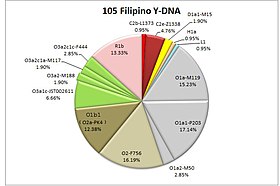Genetic studies on Filipinos
Various genetic studies on Filipinos have been performed, to analyze the population genetics of the various ethnic groups in the Philippines.
The results of a DNA study conducted by the
Origins
The first
A 2008 genetic study by
However, these have been repudiated by a 2014 study published by
Another study about the ancestral composition of modern ethnic groups in the Philippines from 2021 similarly suggests that distinctive
Y-DNA haplogroups


The most frequently occurring
In particular, the type of O2-M122 that is found frequently among Filipinos in general, O-P164(xM134), is also found frequently in other Austronesian populations, including Polynesians.[12][13][14] Trejaut et al. 2014 found O2a2b-P164(xO2a2b1-M134) in 26/146 = 17.8% of a pool of samples of Filipinos (4/8 = 50% Mindanao, 7/31 = 22.6% Visayas, 10/55 = 18.2% South Luzon, 1/6 = 17% North Luzon, 2/22 = 9.1% unknown Philippines, 2/24 = 8.3% Ivatan).
The distributions of other subclades of O2-M122 in the Philippines were sporadic, but it may be noted that O2a1b-JST002611 was observed in 6/24 = 25% of a sample of Ivatan and 1/31 = 3.2% of a sample from the Visayas, O2a2a1a2-M7 was observed in 1/6 = 17% of a sample from North Luzon, 1/55 = 1.8% of a sample from South Luzon, and 1/31 = 3.2% of a sample from the Visayas, and O2a2b1a1a-M133 was observed in 2/31 = 6.5% of a sample from the Visayas.[13] A total of 45/146 = 30.8% of the sampled Filipinos were found to belong to Haplogroup O2-M122.[13]
In a study by Delfin et al. (2011), 21.1% (8/38) of a sample of highlanders of northern Luzon (17
)Haplogroups R-M343 and I-M253
After the 16th century, the colonial period saw the influx of genetic influence from other populations. This is evidenced by the presence of a small percentage of the Y-DNA
The analysis of the full
Haplogroup Q-M242
One study found that the Y-DNA of two out of 64 sampled Filipino males belonged to Haplogroup Q-M242 (which has its highest frequency among Native Americans and Asian Siberians and is also found in other Asians).[19]
Mitochondrial DNA haplogroups
This section needs expansion. You can help by adding to it. (October 2021) |
From India
The Indian Mitochondrial DNA haplogroups, M52'58 and M52a are also present in the Philippines suggesting that there was Indian migration to the archipelago starting from the 5th Century AD.[20]
The integration of Southeast Asia into Indian Ocean trading networks around 2,000 years ago also shows some impact, with South Asian genetic signals that are present in the
See also
References
- ^ "Genographic Project - Reference Populations – Geno 2.0 Next Generation". National Geographic. April 13, 2005. Archived from the original on May 22, 2019.
- ^ ISBN 978-0470016176.
- ^ Mijares, Armand Salvador B. (2006). "The Early Austronesian Migration To Luzon: Perspectives From The Peñablanca Cave Sites". Bulletin of the Indo-Pacific Prehistory Association (26): 72–78. Archived from the original on July 7, 2014.
- ^ Bellwood, Peter (2014). The Global Prehistory of Human Migration. p. 213.
- ^ (PDF) from the original on 2014-06-29. Retrieved 2021-10-20.
- ^ Martin Richards. "Climate Change and Postglacial Human Dispersals in Southeast Asia". Oxford Journals. Archived from the original on October 8, 2012. Retrieved April 10, 2014.
- ^ Rochmyaningsih, Dyna (28 October 2014). "'Out of Sundaland' Assumption Disproved". Jakarta Globe. Archived from the original on 25 December 2018. Retrieved 24 December 2018.
- PMID 33753512.
- ^ a b "With a sample population of 105 Filipinos, the company of Applied Biosystems, analysed the Y-DNA of average Filipinos and it is discovered that about 0.95% of the samples have the Y-DNA Haplotype "H1a", which is most common in South Asia and had spread to the Philippines via precolonial Indian missionaries who spread Hinduism and established Indic Rajahnates like Cebu and Butuan. The 13% frequeny of R1b also indicate Spanish admixture". Archived from the original on 2017-05-25. Retrieved 2021-10-20.
- ^ a b "Manual Collation". Archived from the original on 2022-10-26. Retrieved 2022-10-26.
- ^ a b Philippines DNA Project Archived 2023-02-04 at the Wayback Machine - Y-DNA Classic Chart
- ^ Sheyla Mirabal, Kristian J. Herrera, Tenzin Gayden, Maria Regueiro, Peter A. Underhill, Ralph L. Garcia-Bertrand, and Rene J. Herrera, "Increased Y-chromosome resolution of haplogroup O suggests genetic ties between the Ami aborigines of Taiwan and the Polynesian Islands of Samoa and Tonga." Gene 492 (2012) 339–348. doi:10.1016/j.gene.2011.10.042
- ^ PMID 24965575.
- PMID 20207712.
- ^ PMID 20877414.
- PMID 11916003.
- PMID 26092716. Subsection: (Discussion) "For the non-Hispanic white individuals, we see a broad spectrum of genetic ancestry ranging from northern Europe to southern Europe and the Middle East. Within that large group, with the exception of Ashkenazi Jews, we see little evidence of distinct clusters. This is consistent with considerable exogamy within this group. By comparison, we do see structure in the East Asian population, correlated with nationality, reflecting continuing endogamy for these nationalities and also recent immigration. On the other hand, we did observe a substantial number of individuals who are admixed between East Asian and European ancestry, reflecting ~10% of all those reporting East Asian race/ethnicity. The majority of these reflected individuals with one East Asian and one European parent or one East Asian and three European grandparents. In addition, we noted that for self-reported Filipinos, a substantial proportion have modest levels of European genetic ancestry reflecting older admixture."
- ^ PMID 33753512.
- PMID 21463511.
- PMID 23756438.
Indian influence and possibly haplogroups M52'58 and M52a were brought to the Philippines as early as the fifth century AD. However, Indian influence through these trade empires were indirect and mainly commercial; moreover, other Southeast Asian groups served as filters that diluted and/or enriched any Indian influence that reached the Philippines
